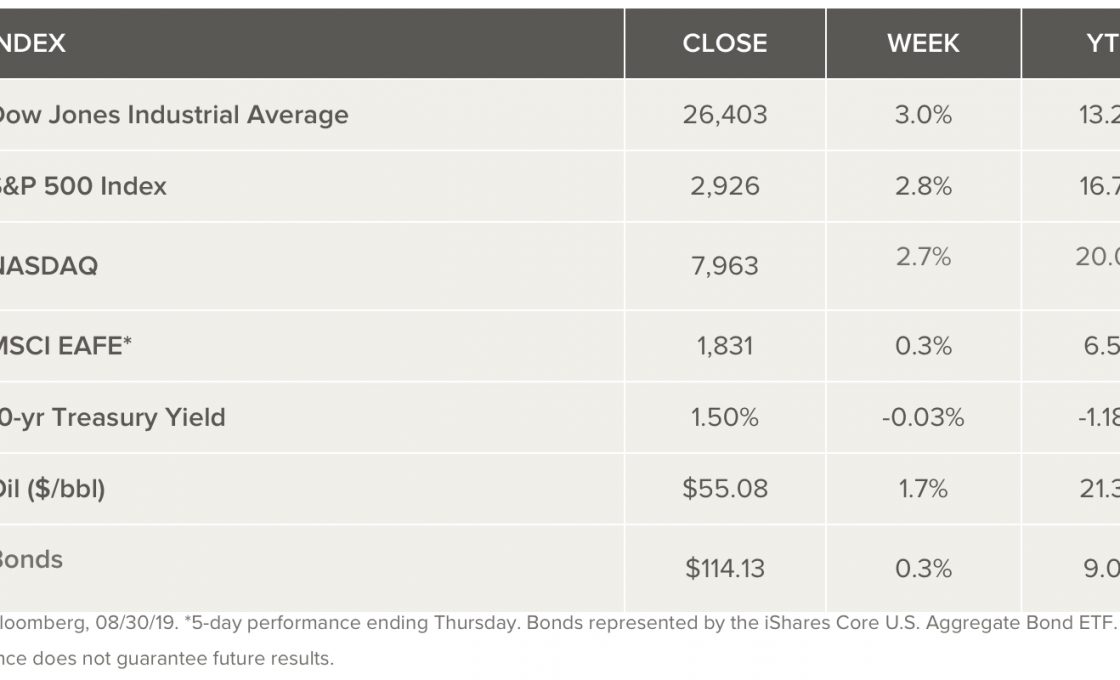Weekly Market Review – September 21, 2019
Stock Markets
After three straight weeks of gains, stocks ended lower overall last week. Several events engaged investors including a spike in oil prices and the Federal Reserve’s second rate cut this year. An unprovoked attack on key Saudi oil placements set off the worst oil supply disruption on record. Estimates suggest 6% of the world’s production was impacted in the event. In response, oil prices jumped 15% but later gave back gains, ending the week 6% higher after officials confirmed that global oil production will be pretty well back to normal by the end of the month. The Federal Reserve lowered its rate by a quarter point as a measure against risks from slowing global growth and the ever-present trade tensions. Analysts expect that accommodative Fed measures can help extend the current expansion, but they also say that aggressive market expectations for the Fed to continue cutting rates could promote volatility over the near term.
U.S. Economy
The Fed rate cuts that we have seen this year are clearly more a choice of wanting to have to offset potential slowing rather than aiding a failing economy. There’s plenty of evidence to support this:
- Unemployment remains at 3.7%, one-tenth of a percent from the lowest level in 50 years. There have now been 107 consecutive months of job growth, the longest streak on record. Wages are rising at an average of 3.2% making it the strongest year in over a decade.
- U.S. GDP growth has averaged 2.7% over the past two years.
- With the economy in pretty decent shape and likely to get ongoing support from household spending, we don’t expect the Fed to aggressively cut rates further from here.
- Core inflation has averaged 2.1% thus far in 2019, below the Fed’s intended longer-term 2% target.
- The slowdown in the manufacturing sector is at least partly a result of the tariff uncertainty.
The bottom line is that the Fed’s preemptive actions could provide the momentum to extend the current economic expansion, or at the very least, prevent monetary conditions from becoming too restrictive, which could serve as a catalyst for a recession.
Metals and Mining
Gold ended steady this week after losing some momentum in mid-week following the US Federal Reserve’s decision to cut interest rates by 25 points to a new target range of 1.75 percent to 2 percent.
The Fed also has taken quite a quite dovish outlook for future possible decreases. Fed Chair, Jerome Powell said the Fed would be keeping an eye on geopolitical concerns and has not ruled out further cuts in the future. Even as gold weakened over the last few weeks, market watchers are expecting that ongoing geopolitical concerns continue to support gold. Also adding to gold’s safe haven investment appeal was an announcement from the US that it was building a coalition to shield itself from Iranian threats following last week’s attack on Saudi oil infrastructure. Silver rebounded Friday to get even closer of the US$18 per ounce level. Silver is being supported by the recent interest rate cut and ongoing geopolitical issues. In other precious metals, platinum was up close to 1 percent Friday, and continues to trade above the US$900 per ounce level. Analysts see the price of the metal rising slightly from its current level as they believe it will continue to trail behind its sister metal palladium. Palladium made solid gains once again, climbing over 1 percent this week.
Energy and Oil
It was what many say was the wildest week for oil in recent history. Prices first spiked, then fell back again, and then gained slowly on Thursday and Friday. There are still some large unanswered questions over Saudi Arabia’s ability to repair its infrastructure damaged by a drone strike as quickly as it claims. The U.S and Saudis are measuring next steps following the attack. Nothing has been left off the table, even more military action is possible.
Analysts suggest that if oil prices move higher because of the outage in Saudi Arabia, it could generate higher U.S. shale drilling rates. But an increase in associated natural gas output would be bearish for gas, they say. “Appalachia producers in particular need to show restraint in order to keep the market balanced into 2020,” Goldman Sachs said in a research note. The events of this week have certainly changed the landscape from both a fundamental and technical viewpoint.
Unless we move back below the 50-day average, an unlikely thing given the renewed focus on geopolitical risk, oil will, likely settle into a new, higher range as the year comes to an end. If that’s true, we are potentially at the bottom. So, setting positions for a move higher could be positive.
Natural gas spot prices fell at most locations this week. Henry Hub spot prices rose from $2.59 per million British thermal units (MMBtu) last week to $2.68/MMBtu this week. At the New York Mercantile Exchange (Nymex), the price of the October 2019 contract rose 9¢, from $2.552/MMBtu last week to $2.637/MMBtu this week. The price of the 12-month strip averaging October 2019 through September 2020 futures contracts rose by 3¢/MMBtu to $2.587/MMBtu.
World Markets
European stock markets were mostly stuck in a range this week. That was set against trade negotiations between the U.S. and China resuming after nearly two months, as well as hopes for a Brexit deal on the rise. The pan-European STOXX Europe 600 Index gained 0.4%, while the German DAX and the UK’s FTSE 100 Index both declined slightly. The British pound traded in a narrow range this week, held steady by hopes for a Brexit deal. Pressure increased on the likelihood that the Bank of England (BoE) will cut short-term rates. European Commission President Jean-Claude Juncker seemed to raise the prospect of a Brexit deal. In his comments, he suggested he was ready to scrap the Irish backstop if UK Prime Minister Boris Johnson could come up with a potential alternative to consider.
Chinese stocks moved down over the week as a whole group of indicators reiterated the continued toll the U.S. trade war is taking on the country’s economy. The benchmark Shanghai Composite Index lost 0.8% and the large-cap CSI 300 Index fell 0.9%. The declines fell on the heels of a trio of indicators released last weekend that showed key drivers of China’s economy slowing. The growth in both industrial output and retail sales in August missed expectations. Meanwhile industrial output had its lowest monthly gain since 2002. In a final note, fixed-asset investment slowed to 5.5% in the first eight months of the year. That was also below expectations.
The Week Ahead
Reporting is relatively light this week with some key economic data being released including the preliminary September Purchasing Manager’s Index, consumer confidence, Case-Shiller home price index, final second-quarter GDP, and likely most important, personal income and spending released on Friday.
Key Topics to Watch
- Chicago Fed national activity
- Markit manufacturing PMI
- Markit services PMI (flash)
- Case-Shiller home price index
- Consumer confidence index
- Weekly jobless claims
- GDP revision
- Advance trade in goods
- Pending home sales index
- Durable goods orders
- Core capex orders
- Personal income
- Consumer spending
- Core inflation
- Consumer sentiment index
Markets Index Wrap Up






















